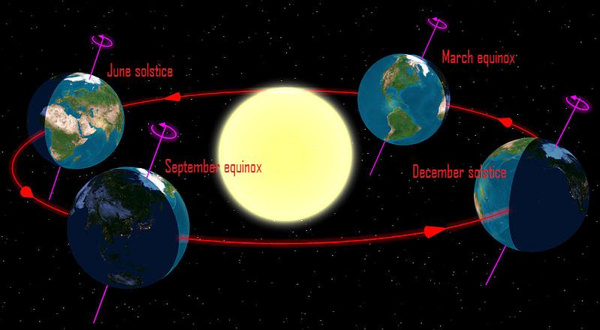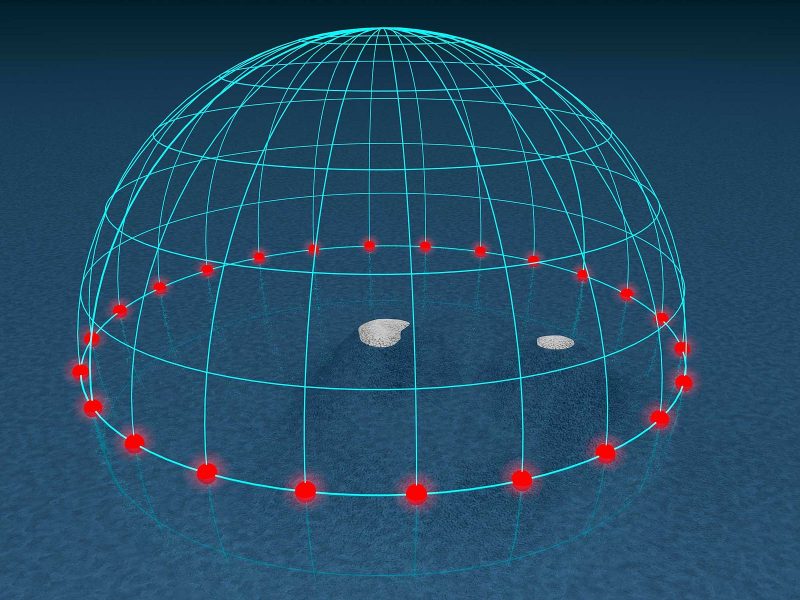
Image above: View at EarthSky Community Photos. | Tasneem Firdaus caught the sun ascending from Dhanbad, Jharkhand, India on March 17, 2021.
The March 2021 equinox happens on March 20, 2021, at 09:37 Universal Time. That’s early morning … March 20 at 4:37 a.m. Central Daylight Time for us in the central U.S. Translate to your time zone.
The March equinox heralds the arrival of spring in the Northern Hemisphere and autumn in the Southern Hemisphere. On this day, the sun rises due east and sets due west.
It might seem counter-intuitive. But it’s true no matter where you live on Earth (except the North and South Poles, where there is no east or west).
To understand the nearly due-east and due-west rising and setting of an equinox sun, you have to think of the reality of Earth in space. First think of why the sun’s path across our sky shifts from season to season. It’s because our world is tilted on its axis with respect to its orbit around the sun.

The seasons result from the Earth's rotational axis tilting 23.5 degrees out of perpendicular to the ecliptic (Earth's orbital plane).
Now think about what an equinox is. It’s an event that happens on the imaginary dome of Earth’s sky. It marks that special moment when the sun crosses the celestial equator going from south to north. And it also, of course, represents a point on Earth’s orbit.
The celestial equator is a great circle dividing the imaginary celestial sphere into its northern and southern hemispheres. The celestial equator wraps the sky directly above Earth’s equator. At the March equinox, the sun crosses the celestial equator to enter the sky’s northern hemisphere.

The celestial equator is a circle drawn around the sky, above Earth’s equator. The ecliptic is the sun’s apparent yearly path in front of the constellations of the zodiac. The ecliptic and celestial equator intersect at the spring and autumn equinox points.
All these components are imaginary, yet what happens at every equinox is very real – as real as the sun’s passage across the sky each day and as real as the change of the seasons.
No matter where you are on Earth (except for the North and South Poles), you have a due east and due west point on your horizon. That point marks the intersection of your horizon with the celestial equator, the imaginary great circle above the true equator of the Earth.
And that’s why the sun rises close to due east and sets close to due west, for all of us, at the equinox. The equinox sun is on the celestial equator. No matter where you are on Earth, the celestial equator intersects your horizon at due east and due west.

Where does the celestial equator intersect your horizon? No matter what your latitude is, it intersects your horizon at points due east and due west. Read more about how an observer’s latitude affects your visible sky.
This fact makes the day of an equinox a good day for finding east and west from your yard or other favorite site for watching the sky. Just go outside around sunset or sunrise and notice the location of the sun on the horizon with respect to familiar landmarks.
If you do this, you’ll be able to use those landmarks to find those cardinal directions in the weeks and months ahead, long after Earth has moved on in its orbit around the sun, carrying the sunrise and sunset points northward.
Our ancestors may not have understood the equinoxes and solstices as events that occur in the course of Earth’s yearly orbit around the sun. But if they were observant – and some were very observant indeed – they surely marked the day of the equinox as being midway between the sun’s lowest path across the sky in winter and highest path across the sky in summer.
If they thought in terms of four directions, they might also have learned a fact of nature that occurs whenever there’s an equinox: each midway point between the sun’s lowest and highest path.
We can say with reasonably good accuracy that the sun rises due east and sets due west on the day of the equinox, as seen from around the globe. If you are seeking more precision for the sunrise/sunset direction in your part of the world, check out the altitude/azimuth for the sun via TimeandDate.com.

The day arc of the sun, every hour, during the equinox as seen on the celestial dome, from the pole. Image via Tau’olunga at Wikimedia Commons.
Bottom line: The 2021 March equinox comes on March 20 at 09:37 UTC (on March 20 at 4:37 a.m. CDT; translate to your time zone). At the equinox, the sun practically rises and sets due east and due west.
A Chinese perspective on the spring equinox
Everything you need to know: Vernal or spring equinox 2020
Read more: Celestial coordinates for beginners
from EarthSky https://ift.tt/2TWG0lZ

Image above: View at EarthSky Community Photos. | Tasneem Firdaus caught the sun ascending from Dhanbad, Jharkhand, India on March 17, 2021.
The March 2021 equinox happens on March 20, 2021, at 09:37 Universal Time. That’s early morning … March 20 at 4:37 a.m. Central Daylight Time for us in the central U.S. Translate to your time zone.
The March equinox heralds the arrival of spring in the Northern Hemisphere and autumn in the Southern Hemisphere. On this day, the sun rises due east and sets due west.
It might seem counter-intuitive. But it’s true no matter where you live on Earth (except the North and South Poles, where there is no east or west).
To understand the nearly due-east and due-west rising and setting of an equinox sun, you have to think of the reality of Earth in space. First think of why the sun’s path across our sky shifts from season to season. It’s because our world is tilted on its axis with respect to its orbit around the sun.

The seasons result from the Earth's rotational axis tilting 23.5 degrees out of perpendicular to the ecliptic (Earth's orbital plane).
Now think about what an equinox is. It’s an event that happens on the imaginary dome of Earth’s sky. It marks that special moment when the sun crosses the celestial equator going from south to north. And it also, of course, represents a point on Earth’s orbit.
The celestial equator is a great circle dividing the imaginary celestial sphere into its northern and southern hemispheres. The celestial equator wraps the sky directly above Earth’s equator. At the March equinox, the sun crosses the celestial equator to enter the sky’s northern hemisphere.

The celestial equator is a circle drawn around the sky, above Earth’s equator. The ecliptic is the sun’s apparent yearly path in front of the constellations of the zodiac. The ecliptic and celestial equator intersect at the spring and autumn equinox points.
All these components are imaginary, yet what happens at every equinox is very real – as real as the sun’s passage across the sky each day and as real as the change of the seasons.
No matter where you are on Earth (except for the North and South Poles), you have a due east and due west point on your horizon. That point marks the intersection of your horizon with the celestial equator, the imaginary great circle above the true equator of the Earth.
And that’s why the sun rises close to due east and sets close to due west, for all of us, at the equinox. The equinox sun is on the celestial equator. No matter where you are on Earth, the celestial equator intersects your horizon at due east and due west.

Where does the celestial equator intersect your horizon? No matter what your latitude is, it intersects your horizon at points due east and due west. Read more about how an observer’s latitude affects your visible sky.
This fact makes the day of an equinox a good day for finding east and west from your yard or other favorite site for watching the sky. Just go outside around sunset or sunrise and notice the location of the sun on the horizon with respect to familiar landmarks.
If you do this, you’ll be able to use those landmarks to find those cardinal directions in the weeks and months ahead, long after Earth has moved on in its orbit around the sun, carrying the sunrise and sunset points northward.
Our ancestors may not have understood the equinoxes and solstices as events that occur in the course of Earth’s yearly orbit around the sun. But if they were observant – and some were very observant indeed – they surely marked the day of the equinox as being midway between the sun’s lowest path across the sky in winter and highest path across the sky in summer.
If they thought in terms of four directions, they might also have learned a fact of nature that occurs whenever there’s an equinox: each midway point between the sun’s lowest and highest path.
We can say with reasonably good accuracy that the sun rises due east and sets due west on the day of the equinox, as seen from around the globe. If you are seeking more precision for the sunrise/sunset direction in your part of the world, check out the altitude/azimuth for the sun via TimeandDate.com.

The day arc of the sun, every hour, during the equinox as seen on the celestial dome, from the pole. Image via Tau’olunga at Wikimedia Commons.
Bottom line: The 2021 March equinox comes on March 20 at 09:37 UTC (on March 20 at 4:37 a.m. CDT; translate to your time zone). At the equinox, the sun practically rises and sets due east and due west.
A Chinese perspective on the spring equinox
Everything you need to know: Vernal or spring equinox 2020
Read more: Celestial coordinates for beginners
from EarthSky https://ift.tt/2TWG0lZ

Aucun commentaire:
Enregistrer un commentaire